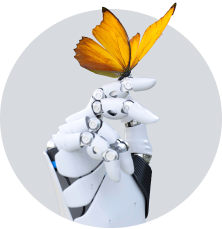From Microlearning to Skill Training with AI Avatars: Discover 6 Global Trends in Corporate Learning
A recent Learning Technologies conference in London confirmed one key truth: the era of long, one-size-fits-all training is over—and so is the idea of skipping employee development altogether. What works now? Bite-sized videos and personalized digital learning. That’s what gets used, sparks growth, and ultimately pays off for companies.

With new technologies, new generations entering the workforce, and a rapidly evolving work environment, employee needs are shifting—and corporate learning strategies need to keep pace. Even a quick review can uncover how your team's needs have changed, and what new tools or methods can make learning more effective.
Here’s how to start implementing the latest trends in your company:
1. Build a Learning Ecosystem
Don’t just toss out a course here and there. Every company should create a well-thought-out learning ecosystem that fits its unique needs. Will it be fully online, hybrid, or offline? What technologies and formats will you include? Development activities should fit together like puzzle pieces. If you’re unsure where to start, bring in an expert. Yes, there’s an upfront cost—but the long-term return is worth it.
2. Think Like Marketers—And Sell Learning to Your People
It’s not just about what learning you offer. It’s about how you sell it. Employees won’t engage if they don’t know what’s available or why it matters. Adopt a marketing mindset: Just like your business markets products to customers, HR needs to market learning opportunities to employees.
Also, track the employee learning journey. Where are they in the process? Just starting out, or already seasoned content consumers? Know when and how to grab their attention with new material. Make it just a few clicks away. For example, Seduo.sk and Seduo.cz offers on-demand learning tailored to each person's current needs.
3. Offer Microlearning—Especially Short Videos
Did you know video captures attention in 90% of people, compared to just 10% with text? It’s visual, fast, and easy to digest. People are already used to scrolling Reels on Instagram or TikTok. Bring that same energy into workplace learning with short, teaser-style videos.
And it’s not just Gen Z. Older generations also appreciate time-saving formats. Microlearning is like a Netflix series: people keep coming back, building on what they already saw. It's also a gateway into deeper learning—think webinars or full-length courses.
London Tip: Put microlearning in your employees’ pockets.
What do people do while waiting five minutes for the tram? Scroll social media. Now imagine they spend that time watching a quick learning video instead. With a mobile app, learning is available 24/7, anytime, anywhere. It becomes as habitual as Netflix—just with more upskilling.
4. Tailor Content to Employees
Personalization is a motivation multiplier. You need to create content for different employee groups—by role, generation, or experience level.
Real-world examples:
- Co-op created an avatar named Lisa, modeled after a Gen Z part-timer, facing common scenarios in that role. It helped younger employees relate and adopt good habits.
- Häagen-Dazs developed a microlearning platform with short video lessons for seasonal staff on how to properly serve customers.
This kind of personalization doesn’t just target the right audience—it pulls employees into the learning experience quickly and efficiently.
5. Bring AI into the Learning Mix
AI is already part of everyday life—and it's revolutionizing learning. It can personalize content, provide always-available virtual mentors, and support onboarding or leadership development.
For example, AI roleplay lets new hires simulate conversations with virtual coworkers or customers—safe practice, zero real-world risk. This stress-free environment fosters faster learning. Other options? VR, simulations, and AI-powered feedback tools.
Are employees overwhelmed by too many course options? AI can guide them—explain what’s available, summarize content, and recommend next steps based on their learning history.
6. Convince Leadership with Data
Is investing in people development worth it? It’s the question HR hears all the time. That’s where ROI (Return on Investment) comes in. Use engagement metrics, course completion rates, and employee feedback (from team members and managers alike) to prove that learning is not just useful—it’s profitable.
If you have data showing how performance improved after a course, or how learning boosted team productivity, you’ve got a strong case for leadership.
How to Advance Learning in Companies?
For example, in Slovakia, about half of employees can access corporate learning—and most do at least occasionally. But only about 37% of those who can actually use it regularly. Why? A mix of reasons.
To modernize learning in your company, focus on these key areas:
- Shift employee mindset – from “I’m doing this for the company” to “I’m doing this for me.” Fun fact: 94% of people globally care about learning at work—and it’s a top reason to stay in their job. In Slovakia, only 16% say learning opportunities would make them change jobs. That’s a gap worth closing.
- Listen to what people want to learn – the best ideas often come from the learners themselves.
- Change leadership’s mindset – learning is not a cost; it’s a performance tool and a growth opportunity. It’s an investment in the future.
- Customize for each generation – Gen Z is entering the workforce with different expectations than their older colleagues. Luckily, tools like AI, microlearning, and personalization help bridge that gap and deliver effective, engaging, and accessible learning for everyone.

Why Training Alone Won’t Keep Employees from Leaving

Transparency, Data, and People: What We Learned at the HR Time Gathering in Zagreb

News for the User Experience Community: UX Research Academy for Everyone – Completely Free













